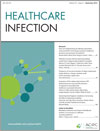
Healthcare Infection
Volume 19 Number 3 2014
HI14003How can implementing an infection prevention and control (IPC) technology transform healthcare practices and outcomes for patients?
Changes in infection prevention and control (IPC) practices resulting from technical innovation can have a major impact on healthcare quality. This discussion paper seeks to introduce a conceptual framework that will make it possible to understand the dynamics involved in implementing practice change. It identifies how new technology integration can translate into different responses to change and into the practices of a network of actors.
HI14008Attitudes towards antimicrobial stewardship: results from a large private hospital in Australia
An effective hospital-wide antimicrobial stewardship (AMS) program requires engagement with all healthcare professionals involved in antimicrobial use, not just prescribers. The aim of this study was to consider attitudes and perceptions among all clinical stakeholders in a large Australian private hospital. Results of the study may be of assistance in introducing AMS to the private hospital sector.
HI14008 Abstract | HI14008 Full Text | HI14008PDF (181 KB) | HI14008Supplementary Material (1.9 MB) Open Access Article
HI14009Frequency of use and activation of safety-engineered sharps devices: a sharps container audit in five Australian capital cities
The incidence of sharps injuries among Australian hospital personnel is unacceptably high and little data is available as to why. This national audit of disposed sharps found only 30% were safety-engineered devices and 20% of safety devices were not activated. The findings offer some explanation as to the high incidence and give strong support for urgent change to occur, including possible legislation.
HI14009 Abstract | HI14009 Full Text | HI14009PDF (414 KB) Open Access Article
HI14010Evaluation of the relationship between ATP bioluminescence assay and the presence of organisms associated with healthcare-associated infections
This study evaluated ATP bioluminescence’s efficacy in determining microbial contamination on 17 surfaces from the healthcare environment, and in determining if the ATP measurements of Acinetobacter baumannii, Candida albicans, Escherichia coli, Enterococcus faecalis, Mycobacterium smegmatis, and methicillin-resistant Staphylococcus aureus corresponded to quantitative microbiology. A strong positive correlation was discovered for each of the six organisms.
HI14006Improving hand hygiene compliance: harnessing the effect of advertised auditing
Good hand hygiene compliance can prevent healthcare-associated infections and when healthcare workers are aware of being observed, adherence may improve further. A prospective observational study carried out to determine the association between advertised hand hygiene auditing and compliance rates revealed an increment of 5.6% in the overall compliance rate.
HI14018Mandatory influenza vaccination of healthcare workers: is it necessary or sufficient to protect patients?
Despite recommendations, a significant proportion of hospital staff is not vaccinated against influenza and there have been calls to make this compulsory. We argue that this is poor policy – it does not automatically lead to better vaccination rates, is difficult to enforce and good vaccination rates are possible without compelling staff to be vaccinated. Further, even complete vaccination of staff may not achieve the ultimate goal of protecting patients from viral infections because the vaccine is only partially effective.

